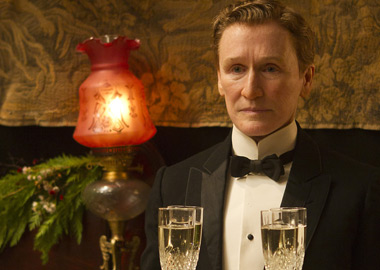In the weeks before this past Christmas, a small but critically praised film was released for a limited run. Like many prestige features released in the late weeks of the year, it was put out primarily to fulfill the requirements for an Academy Award nomination—the requirements state (among other things) that a film must play for a week-long run at a commercial movie house in Los Angeles County during the year prior to the year of the award. (Which is why Charlie Chaplin was able to win an Oscar in 1973 for the score of his 1952 film Limelight; career difficulties had kept the film out of L.A. theaters when it was first released.) I mentioned it in a December column, but few movies get seen during that period, and regular readers may easily have missed what promises to be one of the most unique filmgoing experiences of the year.
The film was The Artist, from French director Michel Hazanavicius. Best known (if known at all in America) for a series of espionage spoofs, Hazanavicius’ latest proves that he has the heart of a film buff, one that pounds an urgent tattoo at names like Fairbanks, Keaton and Valentino. The story of a silent film star—Hazanavicius goes so far as to name him Valentin—at the introduction of the talkie era, it is also a wider story of film history, and, in the widest of wide angles, our own love affair with the medium. Most remarkable of all, however, is that to tell his story, the director returns to that earliest of techniques: the silent film.
“I won’t talk,” says his George Valentin, via a title card. “I won’t say a word.” And he doesn’t have to; his new costar Peppy Miller is all too happy to lead the way into a new era of filmmaking. But while audiences adore Peppy—who quite literally stumbles into her career when she meets Valentin after a film premiere—Valentin begins to seem stale and old-fashioned, and, what’s worse, stubborn. When his studio head (John Goodman, well cast) attempts to interest the actor in the new technology, he is met with a curt rebuff: “If that’s the future, you can keep it,” says Valentin.
Of course, that future has now been improved upon (depending on whom you ask) many times over. Yet none of our inventions has managed to equal the sheer power of the projected image—there’s an elusive magic in that play of light that still outweighs any special effect we might have thrown at us. Show us people, real people, on a screen in the dark. Tell us a story. That, in the end, is all we really ask of our films, and Hazanavicius delivers. Do not miss this film.
*
Also this week: Equally remarkable in its own way is Albert Nobbs, a new film from Rodrigo Garcia (director of Nine Lives and the son of famed writer Gabriel García Márquez). Glenn Close stars in the title role, as a woman in 19th century Ireland who, in order to make the life she desires, lives as a man. The transformation is stunning in its subtlety—Close needs no fake beard, relying instead on changes in bearing and movement to perfect the illusion. It’s an award-winning performance in a film that has drawn somewhat mixed reviews, and Close has a good foil in Janet McTeer, an actress whose character is also living as a man.
The film is something of a dream come true for Close: the actress first played Nobbs in a stage production some 30 years ago, and has been trying for decades to get the film version made. Now that she has finally been able to make it happen—she shares screenwriting credit with Gabriella Prekop and the Irish novelist John Banville—Close has brought the character richly to life once again, creating a personage whose inner and outer lives are increasingly at odds with one another.
Jack Brown can be reached at cinemadope@gmail.com.



